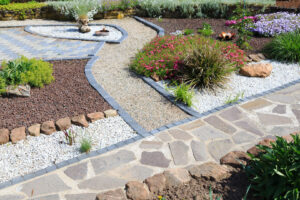
Let’s go over the benefits of decorative gravel and how you can enhance your landscape.
In landscape design, versatility and attractiveness often go hand in hand. Decorative gravel is one of the most versatile and aesthetically pleasing materials for homeowners and landscapers. With various colors, sizes, and textures, decorative gravel magically transforms any landscaping concept or outdoor décor project. Let’s go over the benefits of decorative gravel and how you can enhance your landscape.
Benefits of Decorative Gravel
Beyond its visual appeal, decorative gravel offers several practical benefits, making it a superior choice over other landscaping supplies and materials like mulch or solid paving. For one, gravel is incredibly durable and can withstand weather conditions without deteriorating, making it a long-lasting addition to any landscape. Unlike grass, which requires regular watering, mowing, and other care, decorative gravel is low-maintenance.
Gravel provides excellent drainage, reducing runoff and preventing erosion. Its permeability allows rainwater to soak into the soil, benefiting plants and reducing the burden on drainage systems. Finally, compared to other landscaping materials like paving stones or concrete, gravel is inexpensive and easy to install, making it an economical choice for vast spaces.
Use Gravel to Improve Drainage
Gravel and pebbles can solve acute water accumulation and improve landscape drainage. Installing French drains can redirect water and disperse it away from your home. The gravel prevents debris from collecting and blocking the water flow. Sometimes, a perforated pipe is placed at the bottom of the trench to channel the water better, and gravel is laid over the pipes to keep debris away from the drain.
Decorate Your Driveway
Decorative gravel is an affordable surface option, especially for homes with long driveways. It doesn’t age or crack; when installed with gravel grids, the stone chippings won’t move around as easily. If your property is prone to movement or has large tree roots, gravel driveways provide greater flexibility than pavers.
Colored gravel for driveways adds beautiful hues to an otherwise traditional gray canvas. Maintaining gravel periodically with herbicides to prevent weed growth and adding a new lawyer every two to four years is easier than re-laying or replacing pavers.
Build a Water Feature
Gravel may be a better aesthetic choice for the bottom of ponds, fountains, or other water features because it’s natural-looking and adequately conceals liners. It also lightens the bottom of the pond, fostering a healthy environment for fish. Gravel keeps the water clean and provides a biological environment beneficial for bacteria to break down organic matter and a foundation for aquatic plants to attach to their roots, further encouraging a thriving underwater ecosystem.
Line Your Flower Beds
Gravel is an excellent choice if you want a low-maintenance outdoor space or have poor soil and unstable weather conditions. Unlike mulch, gravel doesn’t decay or deteriorate, so there’s no need for annual replacement. The lack of decay keeps pests away, while its permeability keeps the soil moist. Lastly, because gravel is more stable than soil, flowerbeds keep shape longer and don’t have to be edged as frequently.
Lay Out a Garden Path
Decorative gravel paths are easy and affordable to install. Decorative stone chips for the garden add color to outdoor spaces. A gravel pathway can complement your landscape design and highlight plants, trees, and other garden features.
Garden walkways also provide landscape structure and delineation. They may follow a larger pattern, allow for easier pruning and weeding, and protect the grass and tender plants from being trampled upon.
Questions? Lehnhoff’s Supply is Here to Help
If you still have more questions about using decorative gravel in your landscape, the trained professionals at Lehnhoff’s Supply are here to help you.
Find us at 2708 Belair Road, Fallston, MD 21047 and give us a call at 410-510-7646. For tips, tricks, and to see what we have been up to, be sure to follow us on Facebook, X – Twitter, and Pinterest!
We serve but aren’t limited to, the following parts of Maryland: Harford County – Fallston, Forest Hill, Joppa, Edgewood, Bel Air, Churchville, Havre de Grace, Jarrettsville, Street, Aberdeen, Abingdon, and Joppatowne. In Baltimore County: Kingsville, Perry Hall, Overlea, Fullerton, Nottingham, Parkville, Towson, Carney, Loch Raven, Lutherville, Timonium, Hunt Valley, Cockeysville, Sparks, Glyndon, Pikesville, Reisterstown, Ruxton, Parkton, Glen Arm, Baldwin, Monkton, Long Green, White Marsh, Rosedale, Phoenix, and Fork.
